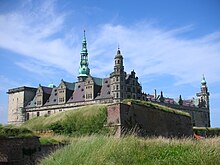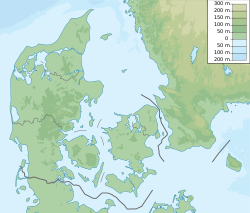
Back قلعة كرونبورغ Arabic قلعة كرونبورج ARZ Кронбарг Byelorussian Кронборг Bulgarian Kastell Kronborg Breton Castell de Kronborg Catalan Kronborg CEB Kronborg Czech Castell Kronborg Welsh Kronborg Danish
| UNESCO World Heritage Site | |
|---|---|
 | |
| Location | Helsingør, Denmark |
| Criteria | Cultural: iv |
| Reference | 696 |
| Inscription | 2000 (24th Session) |
| Website | kongeligeslotte.dk/en |
| Coordinates | 56°2′20″N 12°37′15″E / 56.03889°N 12.62083°E |

Kronborg is a castle and stronghold in the town of Helsingør, Denmark. Immortalized as Elsinore in William Shakespeare's play Hamlet, Kronborg is one of the most important Renaissance castles in Northern Europe. It was inscribed on the UNESCO World Heritage List in 2000.[1]
The castle is situated on the extreme northeastern tip of the island of Zealand at the narrowest point of the Øresund, the sound between present Denmark and the provinces of present Sweden. The latter were under Danish control at the time the castle was built. In this part, the sound is only 4 kilometres (2.5 mi) wide, hence the strategic importance of maintaining a coastal fortification at this location commanding one of the few outlets of the Baltic Sea.
The castle's story dates back to a stronghold, Krogen, built by King Eric VII in the 1420s. Along with the fortress Kärnan in Helsingborg, on the opposite coast of Øresund, it controlled the entrance to the Baltic Sea. From 1574 to 1585, King Frederick II had the medieval fortress radically transformed into a magnificent Renaissance castle. The main architects were the Flemings Hans Hendrik van Paesschen and Anthonis van Obbergen. The sculptural work was coordinated by Gert van Groningen.
In 1629, a fire destroyed much of the castle, but King Christian IV subsequently had it rebuilt. The castle has a church within its walls. In 1658, Kronborg was besieged and captured by the Swedes, who took many of its valuable art treasures as war booty.
In 1785 the castle ceased to be a royal residence and was converted into barracks for the Army. The Army left the castle in 1923. After a thorough renovation, the complex was opened to the public.
- ^ "Kronborg Castle". UNESCO World Heritage Centre. United Nations Educational, Scientific, and Cultural Organization. Retrieved 19 Jun 2021.
